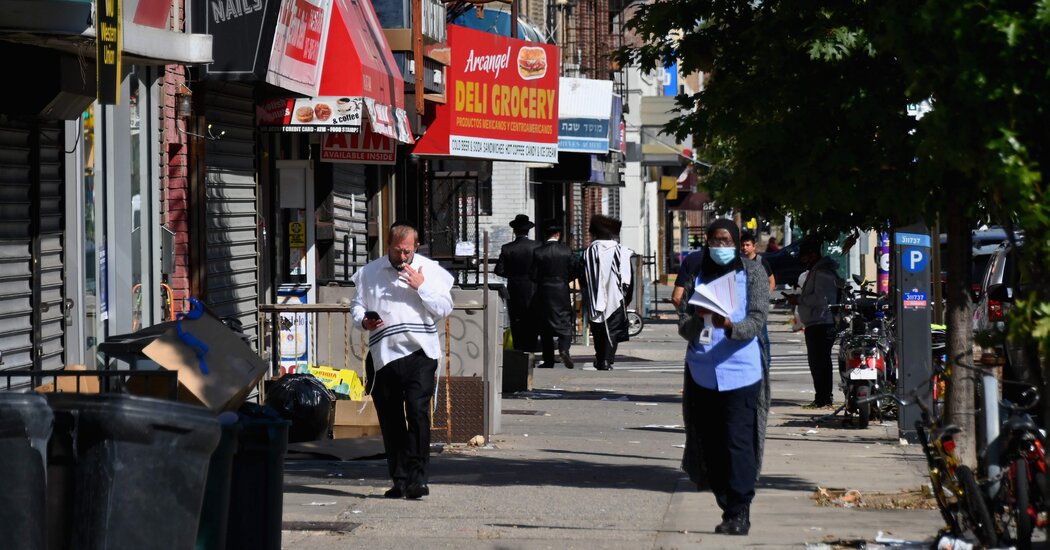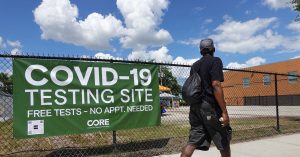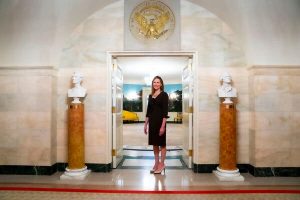Authorities cracked down this weekend on some of the city’s coronavirus hot spots, issuing more than 60 summonses and tens of thousands of dollars in fines to people, businesses and houses of worship that did not follow newly imposed restrictions on gatherings or mask-wearing and social-distancing requirements.
Among those issued a summons by the New York City sheriff were a restaurant and at least five houses of worship in the city’s “red zones,” where coronavirus infection rates are the highest. Each of those locations was given a summons that could result in up to $15,000 in fines, said Sheriff Joseph Fucito.
In total, officials issued 62 tickets and more than $150,000 in fines during the first weekend the new restrictions were in effect, the New York City government Twitter account said on Sunday.
The city is wrestling with its most acute pandemic crisis since the virus first swept through the five boroughs in March. Since mid-August, city and state officials say large gatherings and lax social distancing have caused a surge in new cases in pockets of Brooklyn and Queens, many of them in Orthodox Jewish neighborhoods. The spike prompted Gov. Andrew M. Cuomo to issue new restrictions on large gatherings and nonessential businesses in certain parts of the city.
The moment has set an already anxious city on edge, particularly as doctors, experts and health officials express growing concern about a second wave of the virus this winter. It has also underscored the challenges city officials will face as they try to quash emerging hot spots in small communities before the virus can spread into the rest of the city.
Some religious leaders expressed staunch opposition last week when Mr. Cuomo announced a new executive order, as case numbers continued climbing in pockets of Brooklyn and Queens that are home to large populations of Orthodox Jews.
The Orthodox Jewish community was devastated by the coronavirus in the spring, when local officials and ultra-Orthodox news organizations said hundreds of people might have died, including beloved religious leaders.
#styln-briefing-block {
font-family: nyt-franklin,helvetica,arial,sans-serif;
background-color: #ffffff;
color: #121212;
box-sizing: border-box;
margin: 30px auto;
max-width: 510px;
width: calc(100% – 40px);
border-top: 5px solid #121212;
border-bottom: 2px solid #121212;
padding: 5px 0 10px 0;
}
@media only screen and (min-width: 600px) {
#styln-briefing-block {
margin: 40px auto;
}
}
#styln-briefing-block a {
color: #121212;
}
#styln-briefing-block ul {
margin-left: 15px;
}
#styln-briefing-block a.briefing-block-link {
color: #121212;
border-bottom: 1px solid #cccccc;
font-size: 0.9375rem;
line-height: 1.375rem;
}
#styln-briefing-block a.briefing-block-link:hover {
border-bottom: none;
}
#styln-briefing-block .briefing-block-bullet::before {
content: ‘•’;
margin-right: 7px;
color: #333;
font-size: 12px;
margin-left: -13px;
top: -2px;
position: relative;
}
#styln-briefing-block .briefing-block-bullet:not(:last-child) {
margin-bottom: 0.75em;
}
#styln-briefing-block .briefing-block-header-section {
margin-bottom: 16px;
}
#styln-briefing-block .briefing-block-header {
font-weight: 700;
font-size: 1.125rem;
line-height: 1.375rem;
display: inline-block;
margin-bottom: 5px;
}
@media only screen and (min-width: 600px) {
#styln-briefing-block .briefing-block-header {
font-size: 1.25rem;
line-height: 1.5625rem;
}
}
#styln-briefing-block .briefing-block-header a {
text-decoration: none;
color: #333;
}
#styln-briefing-block .briefing-block-header a::after {
content: ‘›’;
position: relative;
font-weight: 500;
margin-left: 5px;
}
#styln-briefing-block .briefing-block-footer {
font-size: 14px;
margin-top: 1.25em;
/* padding-top: 1.25em;
border-top: 1px solid #e2e2e2; */
}
#styln-briefing-block .briefing-block-briefinglinks a {
font-weight: bold;
margin-right: 6px;
}
#styln-briefing-block .briefing-block-footer a {
border-bottom: 1px solid #ccc;
}
#styln-briefing-block .briefing-block-footer a:hover {
border-bottom: 1px solid transparent;
}
#styln-briefing-block .briefing-block-header {
border-bottom: none;
}
#styln-briefing-block .briefing-block-lb-items {
display: grid;
grid-template-columns: auto 1fr;
grid-column-gap: 20px;
grid-row-gap: 15px;
line-height: 1.2;
}
#styln-briefing-block .briefing-block-update-time a {
color: #999;
font-size: 12px;
}
#styln-briefing-block .briefing-block-update-time.active a {
color: #D0021B;
}
#styln-briefing-block .briefing-block-footer-meta {
display: none;
justify-content: space-between;
align-items: center;
}
#styln-briefing-block .briefing-block-ts {
color: #D0021B;
font-size: 12px;
display: block;
}
@media only screen and (min-width: 600px) {
#styln-briefing-block a.briefing-block-link {
font-size: 1.0625rem;
line-height: 1.5rem;
}
#styln-briefing-block .briefing-block-bullet::before {
content: ‘•’;
margin-right: 10px;
color: #333;
font-size: 12px;
margin-left: -15px;
top: -2px;
position: relative;
}
#styln-briefing-block .briefing-block-update-time a {
font-size: 13px;
}
}
@media only screen and (min-width: 1024px) {
#styln-briefing-block {
width: 100%;
}
}
The new restrictions are the most significant setback yet in the city’s recovery, rolling back some of the successful reopenings that much of New York has embraced since the most restrictive early days of the pandemic this spring.
According to Mr. Cuomo’s executive order, in neighborhoods with the highest infection rates — or “red zones” — houses of worship are limited to 25 percent capacity or a maximum of 10 people. Elsewhere, where rates are lower but still alarming, “orange zones” are limited to 33 percent capacity and “yellow zones” to 50 percent capacity.
“I understand the desire to hold large religious ceremonies. I understand how important it is to their culture and to their religion,” Mr. Cuomo said on a phone call with reporters Sunday. “I also understand that it, as a matter of fact, jeopardizes human life.”
The governor urged rabbis and other Jewish leaders to encourage their congregants to stay home amid reports that many synagogues had openly defied the state’s order and held services in person. Jewish teaching, Mr. Cuomo said, allows religious ceremonies to be postponed for matters of health and safety.
“The likelihood is the virus will spread,” he said.
While the positivity rate in the state’s 20 “red zone” neighborhoods was 5.7 percent, the positivity rate across the rest of New York State was less than 1 percent, with those clusters excluded.
Mr. Cuomo’s order on Tuesday, which came during the Jewish holiday of Sukkot and right before Simhat Torah, spurred immediate backlash in the city’s Orthodox Jewish neighborhoods, where religious leaders accused Mr. Cuomo and Mayor Bill de Blasio of targeting religious minorities.
A national Orthodox organization filed a lawsuit in federal court challenging the constitutionality of the new rules. Protests took place in the Borough Park neighborhood of Brooklyn, where hundreds of demonstrators — most of them Orthodox men, most not wearing masks — burned masks in the streets.
But on Friday, a federal court ruled the new state rules could move forward, citing officials’ responsibility to keep “all New Yorkers” safe.
“How can we ignore the compelling state interest in protecting the health and life of all New Yorkers?” said Judge Kiyo A. Matsumoto of Federal District Court in Brooklyn.
The Catholic Diocese of Brooklyn filed a separate lawsuit objecting to the new restrictions, which it said would force several churches in the borough to close. A judge in that case also ruled that the governor’s order could move forward.
The Sheriff’s Office declined to say if the houses of worship it cited this weekend were churches, synagogues, mosques or other religious institutions.
The office also broke up an illegal rave in Cunningham Park, in Queens, where more than 110 people had gathered and flouted city regulations. The organizers of the event were cited and charged with health code violations, Sheriff Fucito said.
Sheriff Fucito, whose office is one of a handful of city agencies that are responsible for enforcing the new rules, said his agents have rarely cited individuals if they comply with requests to put on masks, or practice better social distancing.
“If they put a mask on, we don’t write a ticket for that,” he said. Most citations written by his office, he said, involve multiple violations or brazen disregard of city rules.
The protests among the Orthodox community appeared to have tempered over the weekend, with no major demonstrations taking place.



















